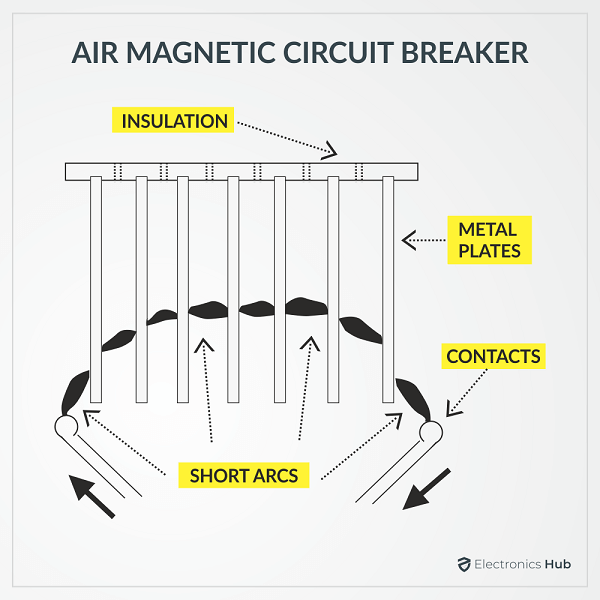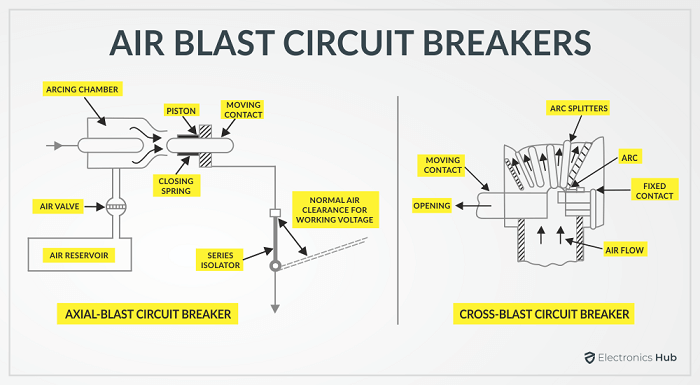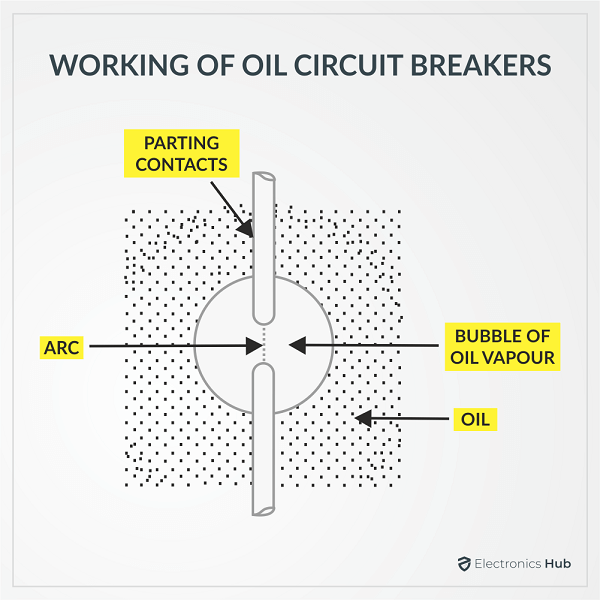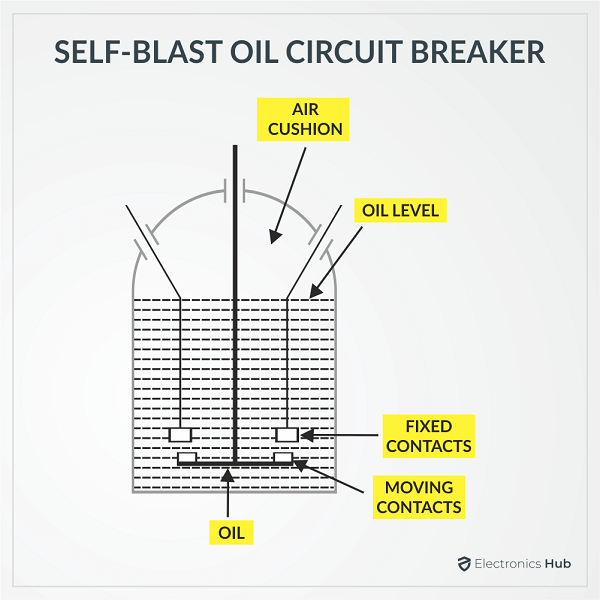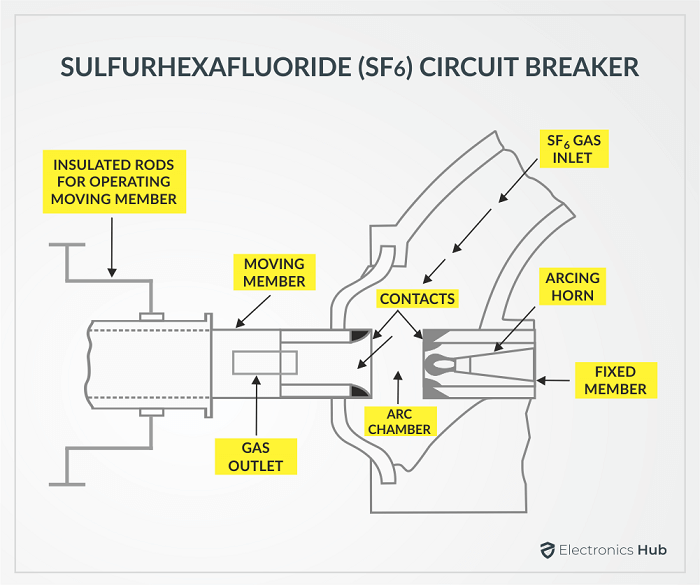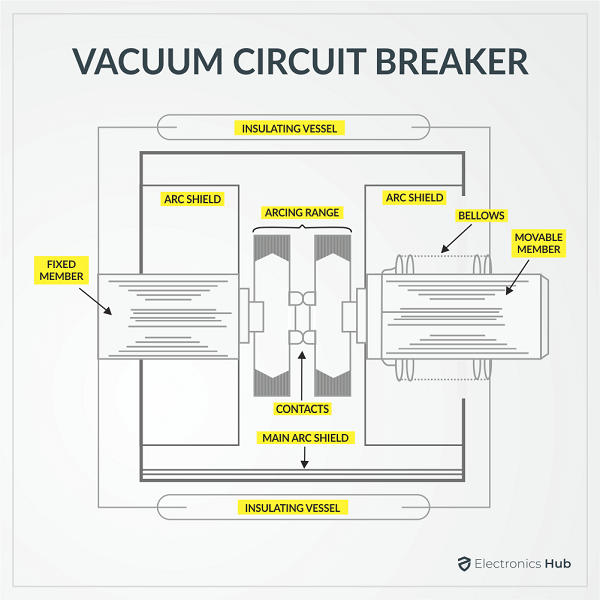In this tutorial, we will learn about one of the very important and extremely useful electrical devices: The Circuit Breakers. We will try to understand what a circuit breaker is, what is the use / importance / function of circuit breakers in power systems, what are the Different Types of Circuit Breakers and also their applications.
Outline
ToggleIntroduction
Circuit Breakers are quite unique devices in the sense that they are mechanical devices connected to electrical system. Since the time when first electrical systems were utilized, there is always a need for a mechanism or a device that can initiate and interrupt the flow of electric current.
In power system, it is often necessary to switch on or off various electrical devices and circuits like generating plants, transmission line, distribution systems, etc. either in normal operating conditions or under abnormal situations. Originally, this task is performed by a switch and a fuse connected in series with the electrical circuit.
The main disadvantage of such a setup is that if a fuse is blown, it is often time consuming to replace one and restore the power supply. The other and main disadvantage is that a fuse cannot interrupt heavy fault currents.
These limitations restricted the usage of switch and fuse combination to small voltage and small capacity circuits. But in case of high voltage and large current system, a more dependable way than using a switch and fuse is desired.
This is achieved with the help of Circuit Breakers.
What are Circuit Breakers?
Circuit Breakers are mechanical switching devices that can make, carry or break a circuit either manually or automatically under normal and abnormal circuit conditions. Under normal conditions, a circuit breaker can make, carry or break currents and under abnormal conditions, it can make or carry for a specific time and break the currents.
The characteristics of a Circuit Breaker are as follows:
- It can make or break a circuit under normal operating conditions either manually or using a remote control.
- Under abnormal or fault conditions, it can break the circuit automatically.
- It can make the circuit under fault conditions either manually or using a remote control.
These characteristics of a Circuit Breaker makes it a very useful device for switching and protection in a power system.
Principle of Operation of Circuit Breakers
The main duty of a Circuit Breaker is to switch ON and OFF the electrical circuits during normal or abnormal operating conditions, once or several times repeatedly. The operating principle of a circuit breaker is very simple.
A typical circuit breaker consists of a fixed and a moving contact called Electrodes. These contacts are closed under normal circuit operating conditions.
If the system becomes faulty, the contacts will open automatically and alternatively, these contacts can also be opened manually whenever desired (for example, during maintenance).
Under faulty system conditions, a simple mechanism will pull the moving contacts away as a result of trip coil getting energized and essentially opening the circuit.
An important phenomenon that occurs during the opening of the contacts is the Arc Phenomenon. If a fault is detected on any part of the system, the contacts of the circuit breaker are separated and during this process, an arc is struck between them. Until the arc discharges, the current in the circuit continues to flow.
The arc not only delays the circuit interruption but also produces a significant amount of heat that could potentially damage the circuit breaker itself or the entire system. Hence, one of the main challenges in circuit breakers is to extinguish the arc as quickly as possible.
Arc Phenomenon in Circuit Breakers
During faulty conditions like a short circuit, for example, a significantly large amount of current flows through the contacts of the circuit breaker before the protective mechanism kicks in and opens the contacts.
The instant when the contacts start to open, the contact area is suddenly reduced and the current density increases due to the large short circuit current. This leads to a rise in temperature and the heat produced is sufficient to ionize the medium (air or oil). The ionized medium acts as a conductor and an arc is struck between the contacts.
This arc provides a low resistance path between the contacts (even though they are open) and the large faulty current continues to flow as long as the arc exists an it defeats the purpose of the circuit breaker.
Reasons for Arc
Before understanding the methods to extinguish arcs, let us try to analyze the factors responsible for the maintaining the arc between the contacts of the circuit breaker.
The reasons can be confined to the following two:
- Potential Difference between the contacts
- Ionized particles between the contacts
The potential difference between the contacts is sufficient for the arc to exist as the separation between the contacts is less. Also, the ionized medium i.e. ionized air or oil have a tendency to maintain the arc.
Different Methods of Arc Extinction
Basically, there are two ways in which you can extinguish the arc between the contacts of a circuit breaker. They are:
- High Resistance Method
- Low Resistance Method
High Resistance Method
In the High Resistance method, the resistance of the arc is increased so that the current will become insignificant to maintain the arc. There are several ways in which you can implement the High Resistance Method.
Some ways to increase the resistance of the arc are:
- Increasing the arc length
- Cooling the arc
- Reducing the area of cross section of the arc
- Splitting the arc
This method is usually implemented in DC Circuit breakers and Low Capacity AC Circuits as it produces enormous amount of heat during the arc extinction.
Low Resistance Method
In the low resistance method, as the name suggests, the resistance of the arc maintained low until the current becomes zero and the arc extinguishes naturally. Hence, this method is also known as Current Zero Method.
The low resistance method is often implemented in high power AC circuit breakers as this method prevents restriking of the arc even when the voltage across the contacts rises.
Another important factor to consider is the ionization of the medium and the tendency of ionized particles to maintain the arc. If the medium between the contacts is deionized, as quickly as possible, the possibility of restriking can be reduced significantly.
Deionization of the medium can be achieved by the following ways:
- Increasing the gap between the contacts
- Increasing the pressure
- Cooling the arc
- Gas Blast effect
Classification of Circuit Breakers
There are several ways of classifying different circuit breakers. Some of the common criteria used for classification of circuit breakers are:
- Intended Voltage Applications
- Location of the installation
- Design Characteristics
- Method and medium used for current interruption (Arc Extinction)
Even though there are several ways to classify circuit breakers, the classification based on the medium and method of current interruption is most general and significant in the industry as well. For now, we will briefly about all these classifications and in the later sections, we will discuss the main classification (i.e. based on method of arc extinction) more thoroughly.
Based on Voltage Class
The first logical classification of circuit breakers is based on the operating voltage intended for the circuit breakers to be used. There are two types of circuit breakers based on the voltage level. They are:
- Low Voltage Circuit Breakers, which are intended to be used at voltages up to 1000V.
- High Voltage Circuit Breakers, which are intended to be used at voltages greater than 1000V.
Again, high voltage circuit breakers are further divided into 123kV or above and 72.5kV or below.
Based on Type of Installation
Circuit breakers are also classified based on the location of installation i.e. outdoor or indoor installation. These circuit breakers are usually high voltage circuit breakers. Indoor circuit breakers are designed to be used inside buildings or with special weather resistant enclosures, usually a metal clad switchgear enclosure.
In fact, the main difference between indoor and outdoor circuit breakers is the packaging structures and enclosures while the internal structure like current carrying parts, interrupting mechanism and operation are pretty much the same.
Based on Type of External Design
The classification of circuit breakers is also done based on the physical structural design and it is usually done in two ways. They are:
- Dead Tank Type Circuit Breakers
- Live Tank Type Circuit Breakers
In Dead Tank Type Circuit Breakers, the switching device is placed in a vessel at ground potential and it is surrounded by interrupters and insulating medium. One the other hand, in a Live Tank Type Circuit Breaker, the vessel containing the interrupters and insulating medium is at higher potential than ground.
Dead Tank Circuit Breakers are more common in the US while Live Tank Circuit Breakers are frequently used in Europe and Asia.
Based on Type of Interrupting Medium
The most significant and important classification of circuit breakers is based on the interrupting medium and arc extinction method. In fact, the current interrupting medium and the arc extinction method have become the main factors in designing the circuit breakers and also, they dictated the overall design parameters.
Originally, oil and air served as the interrupting medium and continue to be still used even after almost a century since their first implementation.
There are two newer techniques, one involving vacuum and the other one based on Sulfurhexafluoride (SF6) gas as the interrupting medium. These two dominate today’s circuit breaker industry but oil and air circuit breakers are also still in service.
Different Types of Circuit Breakers
Since the general and most common way of classification of circuit breakers is based on medium used for arc extinction, we will see different types of circuit breakers based on the same.
Usually, the medium used for extinction of arc is air, oil, Sulfurhexafluoride gas or vacuum. Hence, the different types of circuit breakers based on these media are:
- Air Magnetic Circuit Breakers
- Air Blast Circuit Breakers
- Oil Circuit Breakers
- Sulfurhexafluoride (SF6) Circuit Breakers
- Vacuum Circuit Breakers
Each type has its advantages and disadvantages and we will take a look as all these different types of circuit breakers in detail.
Air Magnetic Circuit Breakers
The first circuit breaker is the Air Magnetic Circuit Breaker. It is also called as Arc Chute Circuit Breaker. Usually, it consists of a number of plates between the contacts and are made up of either metallic or insulated materials.
When the arc is struck, it comes in contact with the series of metal plates. As a result, the main arc is divided into a number of smaller arcs that across the plates and the voltage drop is usually 30 to 40 volts. In this type of circuit breaker, the plates are usually metallic.
Another type of arc chute circuit breaker is based on a magnetic low-out assist. This type usually uses insulated arcing plates and are made of ceramic.
In this type, the arc is first made to travel between the insulating plates to elongate the arc. Then the arc is cooled by diffusion. When the circuit breaker begins to open and the arc is initiated, the separation between the contacts is increased. A coil, which is not part of the main conducting circuit, comes into contact with the current.
The magnetic field created by this coil will exert a force on the arc and as a result, the arc tends to move deeper into the chute.
Air Blast Circuit Breakers
The second ‘air’ based circuit breakers are air blast circuit breakers. In this type, a high-pressure air-blast is used as arc extinguishing medium. In case of a fault, the air-blast, controlled by a blast valve, will open the contacts and also cools the arc.
The arc and the arching products are swept into the atmosphere, which rapidly increases the dielectric strength of the medium. As a result, the restriking of arc is prevented. The arc is extinguished consequently and the flow of current is completely interrupted.
There are three types of air blast circuit breakers based on the direction of the air-blast in relation to the arc. They are:
- Axial Blast Type
- Cross Blast Type
- Radial Blast Type
In axial-blast circuit breakers, the air-blast flows in the same direction as the arc. The high-pressure air-blast will push the moving contact away, opening the circuit and also pushes the arc along with it.
The air-blast in cross-blast type circuit breakers is perpendicular to the arc path and in radial-blast type circuit breakers, it is directed radially.
Advantages
- Risk of fire is eliminated.
- Arcing products are completely removed by the air-blast.
- Significantly faster increase in dielectric strength. Hence, the contact gap can be less, resulting in smaller device.
- Arcing time is very small and the arc energy is also small. Suitable for frequent operations.
- Air-blast is independent to the interrupting current.
Disadvantages
- Arc extinguishing properties of air are inferior.
- Sensitive to variations in restricting voltage.
- Air-blast compressor needs to be maintained.
Oil Circuit Breakers
In Oil Circuit Breakers, an insulating oil is used as the arc extinguishing medium. As the contacts are opened in oil, when the arc strikes, the surrounding oil is evaporated as hydrogen gas.
The hydrogen gas bubble will surround the arc region. Hydrogen gas, due to its high thermal conductivity, cools the arc and also deionizes the medium. Also, the gas causes turbulence in the surrounding oil and all the arcing products are pushed away from the arc.
There are two types of oil circuit breakers. They are:
- Bulk Oil Circuit Breakers
- Low Oil Circuit Breakers
As the name suggests, bulk oil circuit breakers use a significantly large quantity of oil. Further, bulk oil circuit breakers are again divided into two types.
- Plain Break Oil Circuit Breakers
- Arc Control Oil Circuit Breakers
In Plain Break Oil Circuit Breakers, the contacts are separated in the oil tank and the system for arc control is to increase the separation of the contacts. When a critical gap between the contacts is reached, the arc extinction occurs.
The lack of control over the arc in plain break oil circuit breakers is overcome in Arc Control Oil Circuit Breakers. The arc control is implemented in two ways known as:
- Self-blast Oil Circuit Breakers
- Forced-blast Oil Circuit Breakers
In self-blast type breakers, an insulating rigid pressure chamber is used with the contacts and the gases released during arcing are confined to this chamber or pot. The high pressure developed in the small chamber will force the oil as gas to go through the arc and subsequently extinguishing it.
There are three type or designs of pressure pots in Self-blast Oil Circuit Breakers. They are:
- Plain Explosion Pot
- Cross Jet Explosion Pot
- Self-compensated Explosion Pot
Coming to Forced-blast Oil Circuit Breakers, a piston cylinder is used to create the necessary oil pressure in contrast to Self-blast Oil Circuit Breakers, where the pressure is developed by the arc itself.
In all the Bulk Oil Circuit Breakers mentioned above, the oil has two jobs. One is to act as an arc extinguishing medium and the other is to insulate live circuit from earth. Only a small percentage (10% or less) is actually used for arc extinction and the majority of the oil is used for insulating purpose.
In Low Oil Circuit Breakers, oil is used for arc extinction and a solid material like porcelain and paper are used for insulation.
Advantages
- Oil has excellent cooling property and the arc energy converts the oil into gas.
- Acts as insulator between live wires and earth.
Disadvantages
- Oil is inflammable and is a fire hazard.
- Arcing products cannot escape and remain in the oil.
Sulfurhexafluoride (SF6) Circuit Breakers
In Sulfur Hexafluoride circuit breakers, Sulfur Hexafluoride with chemical formula SF6, is used as the arc extinguishing medium.
The Sulfurhexafluoride gas is electro-negative in nature i.e. it attracts free electrons. When the circuit contacts are opened, a high pressure Sulfurhexafluoride gas flows through the chamber as the arc strikes.
Free electrons produced during the arcing are quickly absorbed by the SF6 gas resulting in immobile negative ions. As the arc loses its conducting electrons, the insulating strength of the surrounding medium is quickly increased and the arc completely extinguishes.
Following image shows a simplified construction of SF6 Circuit Breaker. Both the fixed and moving contacts are placed in arc chamber, which contains Sulfurhexafluoride gas. When the contacts open, a high pressure SF6 gas from a reservoir will flow through the chamber’s inlet.
Advantages
- Superior arc extinguishing property.
- Can interrupt larger currents as the dielectric strength of SF6 gas is almost 3 times greater than air.
- Noise free operation and no exhaust into atmosphere.
- Moisture free operation as the gas filled chamber keeps in interior dry.
- Very low maintenance and requires minimum equipment.
- Suitable for hazardous and hostile conditions like coal mines as the breakers are enclosed and sealed.
Disadvantages
- Sulfurhexafluoride gas is very costly.
- SF6 has to be reconditioned after every operation.
- This high pressure Sulfurhexafluoride gas will absorb all the conducting free electrons and as a result causes the extinction of the arc.
Vacuum Circuit Breakers
In vacuum circuit breakers or VCB, the arc extinguishing medium is, well Vacuum. It offers superior arc extinguishing properties than other medium as it has the highest insulating strength.
When the contacts of the circuit breaker in vacuum are opened, an arc is formed due to ionization of the metal vapours of the contacts. But the arc is quickly extinguished as the vapours rapidly condense.
A typical vacuum circuit breaker is shown in the following image. It consists of a moving contact and a fixed contact and also an arc shield mounted in a vacuum chamber. The outer insulating body is usually made up of glass or ceramic.
Advantages
- No fire hazards.
- Compact, very reliable and have very long life.
- No gas is generated during or after operation.
- No or very little maintenance.
- VCB can interrupt any fault current.
- Can withstand lightning strikes.
- Low arc energy is released.

